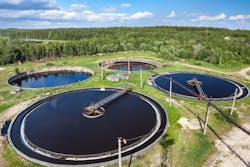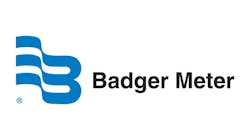Brian Kettner is marketing manager of chemical and valve markets for Badger Meter. Kettner can be reached at [email protected].
Water is among the world’s most essential natural resources. Just as it aids in the development of human life and agricultural products, water is utilized to support various industrial processes, such as heating, cooling and sterilization.
In the water and wastewater industries, control valves are used to isolate pumps and equipment, and to control liquid flow at various stages of treatment. These devices must be engineered for the rigors of use with various chemicals and provide dependable operation from collection to final discharge.
Control valves can be of critical importance for water and wastewater operations. Innovations in valve technology have enabled plant operators to optimize chemical dosing and other corrosive applications, reduce raw material costs, and minimize maintenance and downtime.
Introduction
Clean water is a valuable resource that is increasingly in short supply. To ensure the provision of drinking water for the population and agriculture, as well as water for energy production processes and industry, an increasing number of water treatment plants are being built.
Water and wastewater operations must find ways to meet soaring water demands, and deal with new, higher standards for water quality and pollution controls. They are also under pressure to save energy and upgrade
aging infrastructure.
Wastewater treatment plants process wastewater so it can be safely returned back into the environment. Liquids are processed physically to remove solids, biologically to remove bacteria, and chemically for disinfection.
Control valves are the most important elements in any fluid handling system. They are used to control flow, pressure, temperature and consistency. The valves are positioned by a variety of input signals and powered by either an electric or pneumatic actuator.
Operating Challenges
Effective water and wastewater treatment is equally critical for industrial and commercial organizations. This includes metering effluent for surcharge reporting and precisely measuring influent water, making it easier to manage operations.
Throughout the water and wastewater industry, current trends include:
- Growing demand on water supplies;
- Increasing regulatory standards;
- Aging operational assets;
- Rising energy costs; and
- Reduced staff levels.
Regulatory standards established by the U.S. Clean Water Act, National Pollutant Discharge Elimination System, Effluent Limitation Guidelines, and the National Sanitation Foundation dictate effective water usage, treatment and disposal techniques. Moreover, water conservation is a social responsibility for utilities and businesses.
Process flow control is becoming an increasing concern for water and wastewater plant operators. Budgets are tightening, resulting in a greater need for reliable equipment with a low cost of ownership. At the same time, treatment standards are becoming tighter, emphasizing the need to improve process efficiency during different stages of treatment.
Demanding Plant Processes
Water and wastewater treatment facilities are complex and involve a wide range of fluid flow measurement and control tasks. These applications demand the highest instrument accuracy and reliability, as well as long-term stability and a low cost of ownership.
Typical applications for control valves include:
- Bulk chemical injection;
- Chemical dosing/dilution;
- Reverse osmosis;
- Desalinization;
- Membrane systems;
- Neutralization process;
- Media filtration; and
- Chemical transfer/handling.
Chemical feed is one of the most critical operations in any water and wastewater facility. It involves liquids in both solution and concentrated form, including sodium hypochlorite (NaOCI), sodium bisulfite (NaHSO3), hydrofluosilicic acid, caustic soda, potassium permanganate (KMnO4), polymer, coagulants, methanol and corrosion inhibitors. Gas applications can involve chlorine, ammonia and sulfur dioxide.
A well-engineered chemical feed system is an integral part of a water treatment program. Some of the problems associated with poor chemical control include:
- High chemical costs due to overfeed problems;
- Inconsistent quality, reduced throughput, and higher utility costs due to waterside fouling;
- High corrosion rates and resultant equipment maintenance and replacement;
- High labor costs due to an excessive requirement for operator attention; and
- Risk of severe and widespread damage to process equipment due to poor control or chemical spillage.
A high-accuracy feed rate is crucial in bulk chemical injection. A flow range of 1 to 13 gal per hour (gph) (5 gph nominal) characterizes the process. In gallons per minute (gpm), the flow range is 0.0167 to 0.2167 gpm (0.083 gpm nominal). As such, low-flow control is essential to this operation.
A significant investment in chemical feed equipment often can be justified when compared with the high cost of control problems. When a chemical feed system is not properly engineered,
chemical levels often are above or below required specifications.
Latest Technology Advancements
Over the past 30 years, water and wastewater treatment has seen dramatic changes as populations increase and concern over the environment grows. Stricter regulations for water quality have been met with high-tech engineering in the area of process instrumentation technology.
Control valves manipulate a flowing fluid, such as steam, water, or chemical solutions to compensate for load disturbance and keep the regulated process variable as close as possible to the desired set point. Choosing the right valves can have significant implications for the system’s performance, safety, efficiency and longevity.
Control valves used in water and wastewater operations need to conform to a number of criteria. The material from which a valve is made is important for these applications, as the device must withstand any conditions with which it may come into contact. Valves require corrosion protection against aggressive chemical solutions, acids or alkaline solutions.
The current choice of control valve technology is broad and diverse, ranging from process valves to specialty valves. Valves can be customized with different flange types and sizes, welded connections, and NPT or tube fittings. Moreover, they are available with a wide variety of trims; standard and special bonnets; conventional and low-emission seals; pneumatic, electric or manual actuation; and an array of accessories.
Recently, valve manufacturers have developed polyvinylidene fluoride (PVDF) Kynar control valves optimized for corrosive service and control of chemical dosing in water and wastewater and other industries. PVDF is a strong, hard and lightweight fluorocarbon resin with excellent chemical resistance. Based on the actual chemical service, a PVDF valve can function at up to 302°F (150°C).
Kynar PVDF material offers protection against chemical corrosion from chlorinated and brominated solvents, as well as almost all acids. It also provides corrosion capabilities at both ambient and elevated temperatures. PVDF is ultraviolet stable and mechanically tough, and provides strong resistance to abrasion, which matters when dealing with slurries or other solutions with particulates.
For example, water and wastewater facilities seek to eliminate pathogens during water treatment using sodium hypochlorite–the active ingredient in household laundry bleach. Sodium hypochlorite is inherently an unstable compound. Two things can happen to it that will affect the choice of a control valve. Sodium hypochlorite can decompose over time, which results in the formation of crystalline salts, and as it decomposes, one of the decomposition byproducts is oxygen gas.
Because sodium hypochlorite is a corrosive chemical, plants require a dosing solution that can withstand harsh conditions. Chemical feed pump systems employed in this application require frequent maintenance for hose pumps, check balls, diaphragm pumps and other components. The need for redundant pumps also drives up total equipment and repair costs.
Kynar valves are ideal for use with sodium hypochlorite processes. Kynar is impervious to corrosion, and with certain designs, valves employing this material can automatically compensate for line pressure changes that occur as the level in chemical tanks falls.
These control valves deployed in a system with smart electronic actuators and electromagnetic flow meters enable operators to dispense an accurate chemical dosage, resulting in controlled raw material costs and improved regulatory compliance. Maintenance and downtime are minimal due to the high chemical resistance of the valve’s fluorocarbon material. This solution provides equal percentile trim to allow for maximum controllability of low flow rates. In addition, the use of an electronic actuator enables smooth, highly accurate valve positioning with positive position-lock when not in motion.
Operator Benefits
Faced with aging infrastructure and increasing regulatory requirements, water and wastewater industry facilities are tasked with finding ways to improve performance and efficiency. The goal is to achieve operational excellence, minimizing energy use while enhancing equipment reliability and operator effectiveness.
When selected and deployed properly, control valve solutions can help water and wastewater treatment plants operate safely and consistently to avoid unnecessary maintenance costs and unexpected downtime.
Facility operators now can choose control valve designs that are impervious to corrosion from chemicals used in water treatment processes and automatically compensate for line pressure changes caused by fluctuating levels in chemical injection tanks. These advanced instruments accurately measure low flows to enable precise feed of the chemical dosage, providing significant cost advantages. Furthermore, service and repair are minimal due to the high chemical resistance of the valve.
Conclusion
Water and wastewater operations involve a number of rigorous tasks requiring the highest level of measurement and control performance. Control valve technology, in particular, plays a vital role in these processes.
Key to the outcome of any control valve project is the assistance of qualified engineers, who analyze the application to ensure the right instruments are selected and sized correctly. Instrument manufacturers that understand valve performance can share those capabilities and show they conform to a user’s performance specifications.


